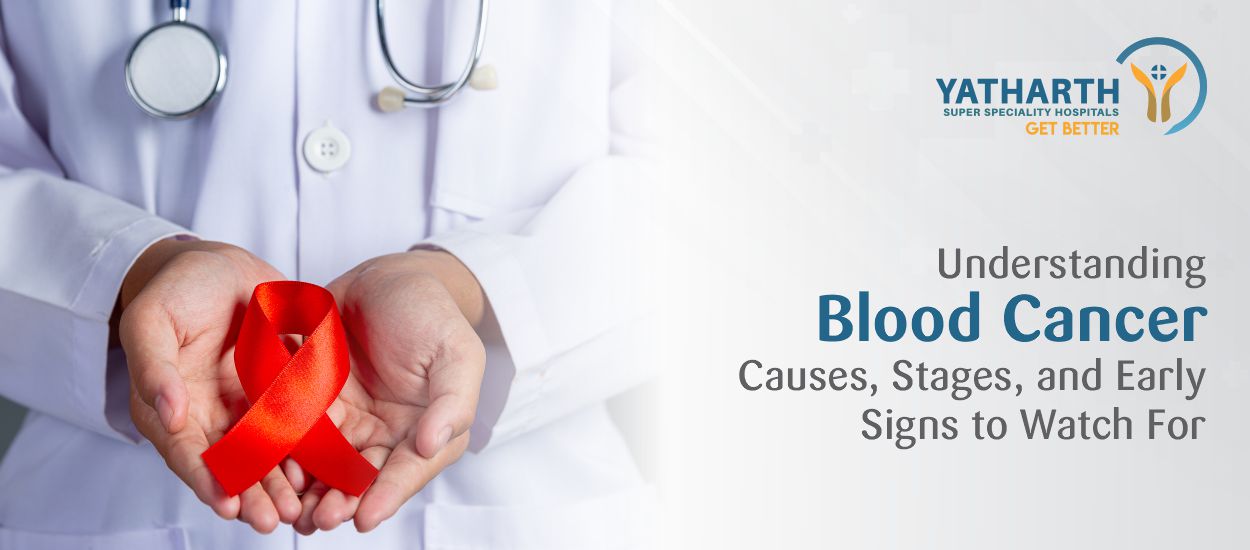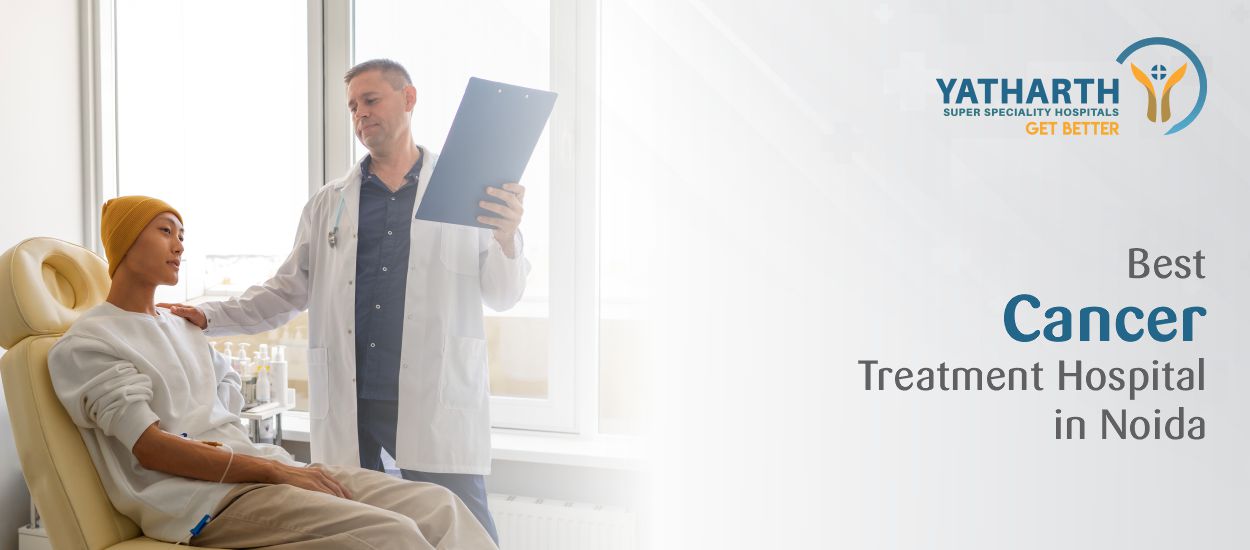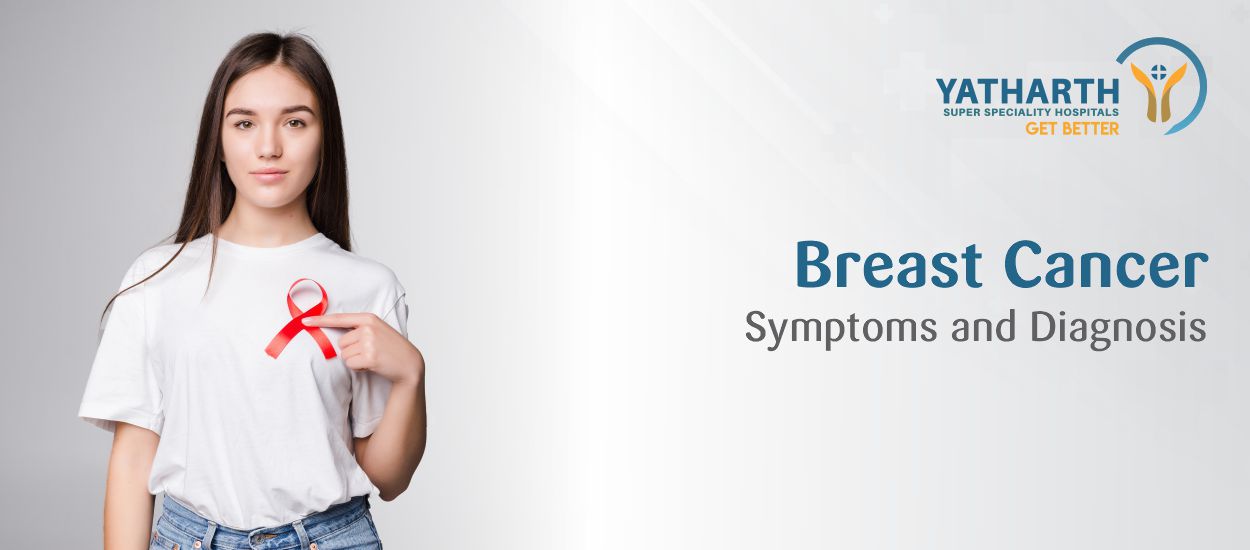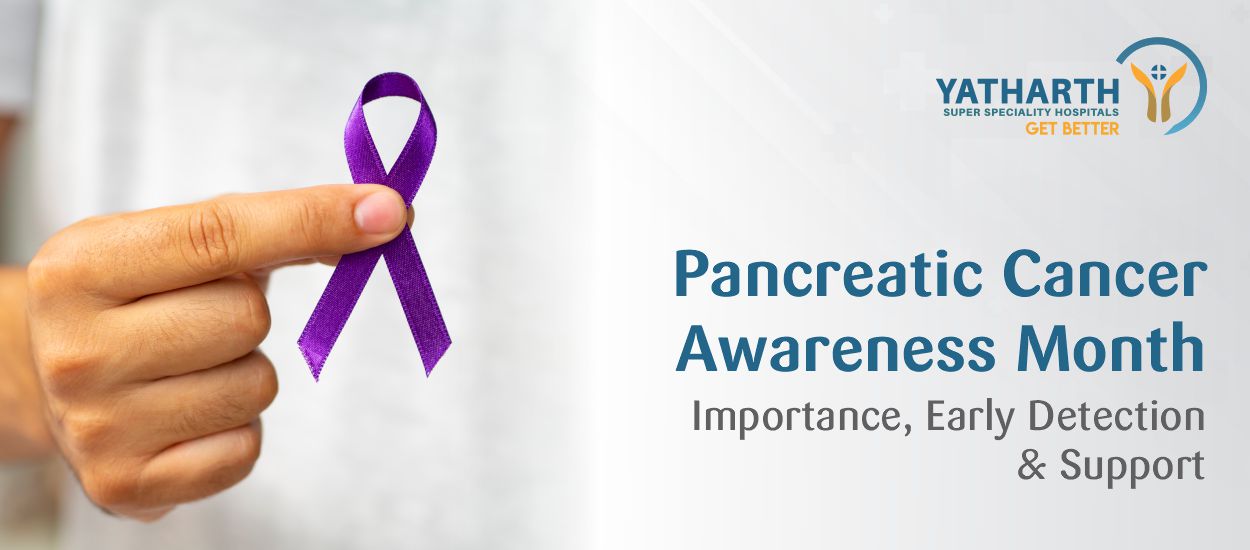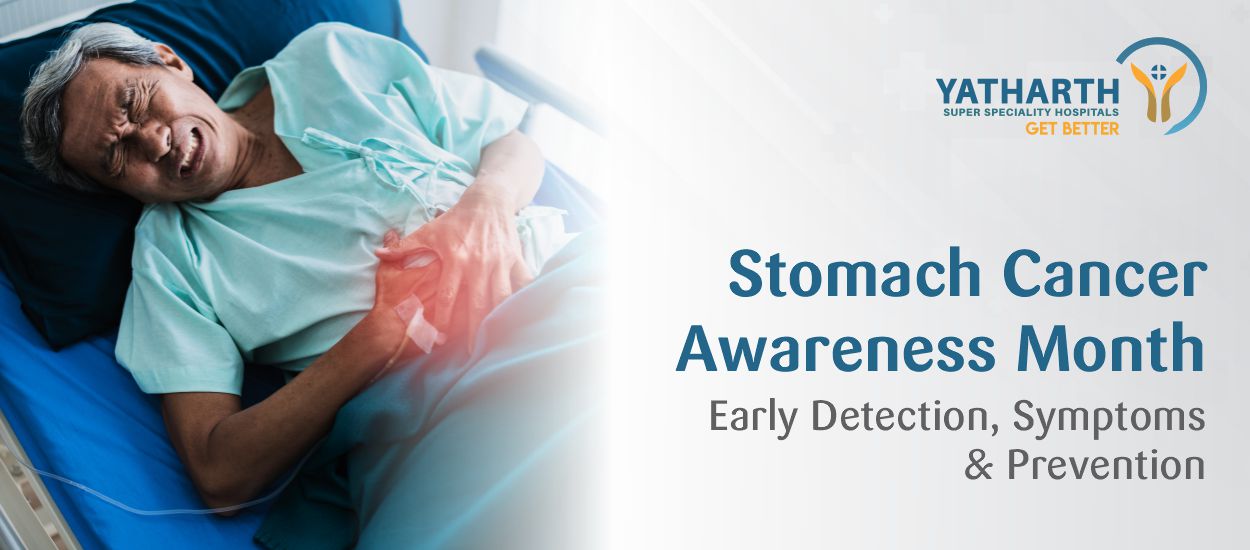Blood cancer is a serious condition that affects the body’s ability to produce and regulate healthy blood cells. Blood cancer, as the name suggests, begins in the bone marrow, where blood cells are produced, and leads to the uncontrolled growth of abnormal cells that disrupt vital functions of the blood, such as fighting infections, carrying oxygen, and controlling bleeding. Over time, these cancerous cells multiply rapidly and suppress the production of healthy cells, weakening the immune system and disrupting the body’s balance. Understanding the causes, stages, and early warning signs of blood cancer is essential for timely diagnosis and effective treatment, as early detection can significantly improve treatment outcomes. In this article, we’ll discuss the causes of blood cancer, its early symptoms, stages, and how it is diagnosed to help you understand the condition better and recognise warning signs early. Let’s start by understanding the basics.
What is Blood Cancer?
Blood cancer, also known as haematologic cancer, starts in the bone marrow, where new blood cells are made. Normally, the bone marrow produces three main types of blood cells: red blood cells (to carry oxygen), white blood cells (to fight infections), and platelets (to help the blood clot). In blood cancer, the bone marrow begins to produce abnormal cells that grow uncontrollably. These faulty cells multiply and suppress the production of healthy ones, making it harder for the body to stay healthy and function properly.
Types of Blood Cancer
Blood cancer is broadly classified into three main types based on the kind of blood cells affected and how the disease progresses. Here’s an overview of the primary types:
1. Leukaemia
Leukaemia starts in the bone marrow and affects the white blood cells, leading to their uncontrolled growth. These abnormal cells crowd out healthy ones, reducing the body’s ability to fight infections, produce red blood cells, and control bleeding. It can be acute (fast-growing) or chronic (slow-growing). Some common forms of leukaemia include:
-
Acute Myeloid Leukaemia (AML)
-
Acute Myeloblastic Leukaemia (AMBL)
-
Acute Monocytic Leukaemia (AMoL)
-
Acute Myelomonocytic Leukaemia (AMML)
2. Lymphoma
Lymphoma develops in the lymphatic system, which helps the body fight infections. It occurs when lymphocytes (a type of white blood cell) grow abnormally and build up in the lymph nodes, spleen, or other organs. The two main subtypes of lymphoma are:
-
Non-Hodgkin’s Lymphoma: A broader group that includes many subtypes of lymphoma.
-
Hodgkin’s Lymphoma: Identified by the presence of Reed-Sternberg cells.
3. Myeloma (Multiple Myeloma)
Myeloma, also known as multiple myeloma, begins in plasma cells - a type of white blood cell that produces antibodies to help fight infections. When these cells become cancerous, they multiply uncontrollably and build up in the bone marrow, interfering with normal blood cell production and causing complications such as bone pain, anaemia, and kidney problems.
Stages of Blood Cancer
The stage of blood cancer shows how advanced the disease is and how much it has affected the body. Although each type of blood cancer has its own specific staging system, most follow a similar pattern that helps doctors understand the extent of the disease and plan appropriate treatment. Different stages of blood cancer are:
-
Stage I: Cancer is limited to one area, such as a group of lymph nodes or the bone marrow.
-
Stage II: Cancer spreads to nearby lymph nodes or tissues.
-
Stage III: Multiple lymph nodes or organs are affected.
-
Stage IV: Cancer has spread to several organs or bone marrow throughout the body.
Some types, such as leukaemia, are described as acute (fast-growing) or chronic (slow-growing) instead of being assigned numbered stages.
Causes and Risk Factors of Blood Cancer
The exact cause of blood cancer is not fully understood, but doctors know that it usually begins when the DNA inside certain blood cells changes or mutates. These changes make the cells grow and divide uncontrollably, instead of dying when they should. Over time, these abnormal cells build up in the bone marrow and interfere with the production of healthy blood cells.
Although anyone can develop blood cancer, some factors may increase the risk, such as:
-
Family history: Having a close relative with blood cancer can increase one’s risk, although not everyone with a family history develops the disease.
-
Exposure to radiation or harmful chemicals: Long-term contact with substances such as benzene (found in cigarette smoke, petrol, and industrial emissions) or pesticides can damage bone marrow cells and increase cancer risks.
-
Weak immune system: Individuals with weakened immune systems, due to conditions like HIV/AIDS, autoimmune diseases, or organ transplants, are more prone to developing blood cancers such as lymphoma.
-
Viral infections: Infections caused by viruses such as Epstein-Barr virus (EBV), Human T-cell leukaemia virus (HTLV-1), and Human Immunodeficiency Virus (HIV) are known to contribute to the development of specific blood cancers.
-
Previous cancer treatment: Chemotherapy or radiation therapy for another cancer can sometimes trigger blood cancer years later.
-
Age and gender: The risk increases with age and is slightly higher in men for some types of blood cancer.
Having one or more of these risk factors does not mean a person will definitely develop blood cancer. However, being aware of them and getting regular health check-ups can help detect any changes early.
Early Signs and Symptoms of Blood Cancer
Blood cancer can develop slowly, and in its early stages, the symptoms may seem minor or similar to those of common illnesses such as flu or fatigue. Because of this, it often goes unnoticed until it progresses. Knowing the early signs can help in identifying the disease at a stage when treatment is most effective. Common symptoms of blood cancer include:
-
Tiredness and weakness: Feeling exhausted even after enough rest.
-
Unexplained weight loss: Losing weight without any change in diet or activity.
-
Fever or night sweats: Repeated episodes of fever or sweating heavily at night.
-
Frequent infections: Falling ill often because the body’s immune system becomes weaker.
-
Easy bruising or bleeding: Bruising easily, bleeding gums, or frequent nosebleeds without clear cause.
-
Bone or joint pain: Aching or discomfort in the bones, arms, or legs.
-
Swelling of lymph nodes: Noticeable lumps under the neck, arms, or groin.
-
Shortness of breath or pale skin: Caused by a shortage of healthy red blood cells.
Recognising Early-Stage Blood Cancer Symptoms
In the first stage, symptoms can be mild and easily mistaken for general tiredness, stress, or a viral infection. People may experience slight fatigue, frequent colds, or minor bleeding such as gum irritation. If these symptoms persist for more than a few weeks, it is important to consult a doctor and get tested to rule out underlying causes.
Early diagnosis through simple blood tests can make a significant difference in managing blood cancer successfully.
How is Blood Cancer Diagnosed?
Because the early symptoms of blood cancer can resemble common illnesses, doctors use several tests to confirm the diagnosis and identify the specific type of cancer. Detecting the disease early can greatly improve treatment results and overall recovery. Tests commonly used to diagnose blood cancer include:
-
Physical examination: The doctor checks for swollen lymph nodes, enlarged organs (such as the liver or spleen), and signs of infection or anaemia.
-
Complete Blood Count (CBC): This test measures the number and quality of red blood cells, white blood cells, and platelets. Unusual results can be the first sign of blood cancer.
-
CRP blood test: Helps detect inflammation or hidden infection, which may appear in certain cancers.
-
Bone marrow aspiration or biopsy: A small sample of bone marrow is taken, usually from the hip bone, to examine whether abnormal cells are present.
-
Cytogenetic and molecular testing: These tests study the DNA of blood cells to look for genetic mutations or chromosome changes linked to blood cancer.
-
Flow cytometry: Helps identify the exact type of cancer by analysing how blood cells behave.
-
Imaging tests (CT, MRI, PET-CT): Used to find out if the cancer has spread to other parts of the body.
Together, these tests help doctors understand the nature and extent of the disease, which is crucial for planning the most effective treatment.
Treatment Options for Blood Cancer
Treatment for blood cancer has improved greatly in recent years. Doctors now have several effective ways to control the disease, manage symptoms, and help patients live longer and healthier lives. The type of treatment depends on the kind of blood cancer, its stage, and the person’s overall health.
Common treatment options include:
-
Chemotherapy: This uses strong medicines to kill cancer cells or stop them from growing. It can be given through tablets or injections and is often used in several rounds (called cycles).
-
Targeted therapy: These medicines attack specific changes inside cancer cells that help them grow. Because they focus only on abnormal cells, they usually cause fewer side effects than chemotherapy.
-
Immunotherapy: This treatment boosts the body’s own immune system to find and destroy cancer cells more effectively.
-
Stem cell or bone marrow transplant: In this procedure, damaged bone marrow is replaced with healthy stem cells. It helps the body make normal blood cells again after chemotherapy or radiation.
-
Radiation therapy: Uses high-energy rays to destroy cancer cells or shrink tumours. It can also help control pain or other symptoms when the cancer has spread.
Doctors often combine two or more of these treatments for the best results. During treatment, patients are also given supportive care, such as medicines to prevent infection, nutritional advice, and counselling, to help them stay strong and recover better.
Prevention and Risk Reduction
Not all cases of blood cancer can be prevented, but making healthy lifestyle choices and avoiding certain risk factors can help reduce the chances of developing it. Regular health check-ups and paying attention to unusual symptoms also play an important role in early detection.
Simple steps that may help lower the risk include:
-
Avoiding harmful chemicals: Try to limit contact with substances such as pesticides, benzene, and other industrial chemicals that can damage bone marrow.
-
Quitting smoking and limiting alcohol consumption: Both can weaken the immune system and increase the risk of cell damage.
-
Eating a balanced diet: Include fruits, vegetables, whole grains, and foods rich in antioxidants to support immunity and overall health.
-
Staying active: Regular physical activity helps the body maintain good circulation and strengthens immune defences.
-
Protecting against infections: Stay up to date with vaccinations and practise good hygiene to prevent long-term infections linked to some cancers.
-
Scheduling Regular health check-ups: Routine blood tests can help detect early changes in blood cell counts, especially for people with a family history or other risk factors.
While these steps cannot guarantee prevention, they help the body stay strong and may reduce the likelihood of developing serious blood disorders in the future.
Living with Blood Cancer: Support and Recovery
Living with blood cancer can be challenging, both physically and emotionally. Treatment may take time, and recovery often involves ongoing care and support. With proper medical follow-up, healthy habits, and emotional strength, many people are able to manage the condition and lead fulfilling lives.
Here are some ways to cope and support recovery:
-
Regular follow-up visits: Routine check-ups and blood tests help doctors track progress, detect any relapse early, and adjust treatment if needed.
-
Eat well and stay hydrated: A balanced diet rich in protein, vitamins, and fibre helps the body rebuild strength after chemotherapy or radiation.
-
Stay active at your own pace: Gentle exercises like walking or yoga can improve energy levels and reduce stress.
-
Manage side effects: Inform the healthcare team about any symptoms such as nausea, fatigue, or infections so they can be managed early.
-
Emotional well-being: Talking to counsellors, joining support groups, or sharing experiences with other patients can ease anxiety and provide motivation.
-
Focus on rest and recovery: Getting enough sleep and managing stress through relaxation techniques or hobbies can help improve both physical and mental health.
Recovering from blood cancer is a gradual process, and emotional support from family, friends, and healthcare professionals makes a significant difference in the journey towards normal life.
Seeking Timely Medical Care
Being aware of the early signs and risk factors of blood cancer can make a crucial difference in detecting the disease at a treatable stage. Regular health check-ups and timely medical attention are key to preventing complications and improving outcomes.
If you or someone you know is showing persistent symptoms or has concerns about blood-related health issues, it’s important to seek professional guidance from a qualified specialist. For expert consultation or more information, call +91-9582833333 or schedule the appointment online.
